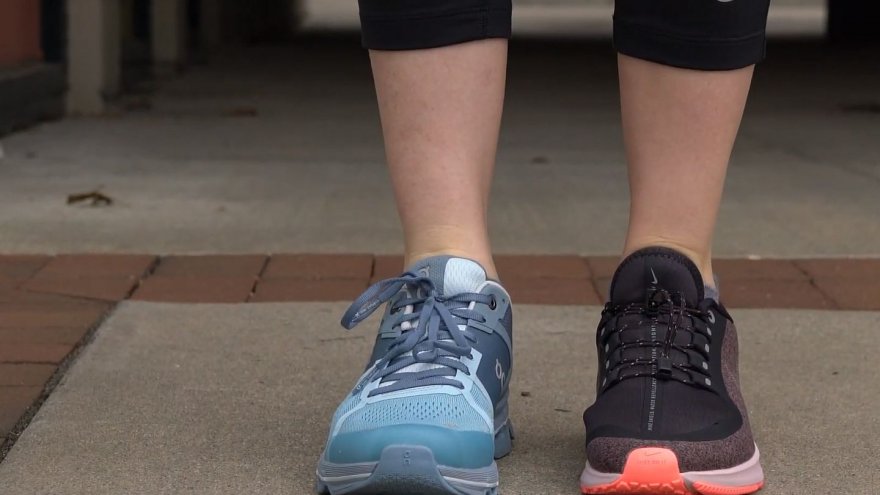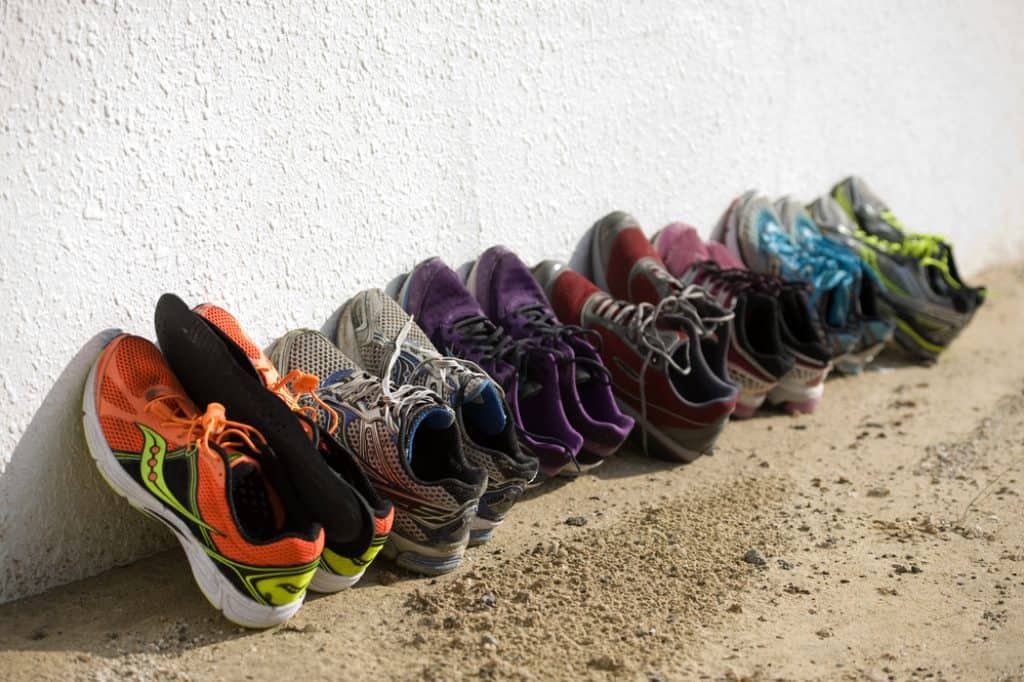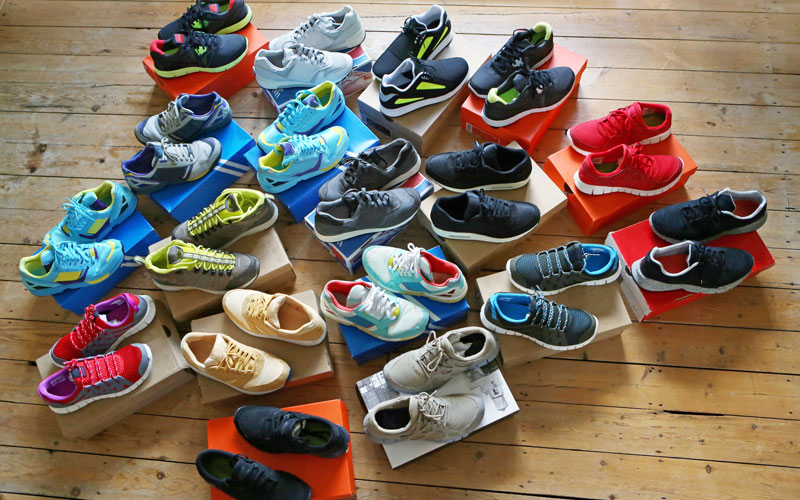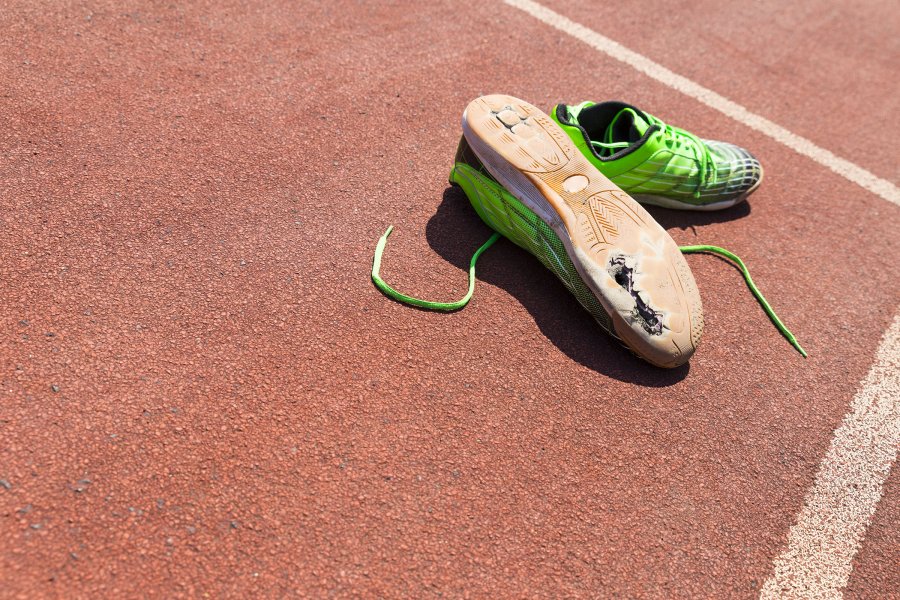How Often Should You Replace Running Shoes?

Any avid runner will tell you that you probably need more than one pair of shoes. By need, I really mean need. Of course, I am kind of speaking tongue in cheek. Some people run in the same pair of trainers day after day and only replace them when they feel so broken down that the runner starts to fear potential injury.
However, other runners keep schedules, rotate shoes, and have set in stone running shoe replacement criteria. Prior to delving into how often should you replace running shoes, let’s talk about shoe rotation to keep your feet and legs happy.
Is It Good To Rotate My Running Shoes?
Many runners swear by rotating running shoes in order to remain injury-free. If you run 4-5 days each week, you can easily rotate between two pairs of shoes. If you run 5 or 6 days each week, you may want to consider having 3 or 4 pairs in your rotation.
If you do not run in the same pair of shoes two days in a row, you give each pair time for the cushion to pop back into shape and position. You see, running day after day in the same pair does not give the shoe recovery time. Some people remedy that by rotating between two pairs.

Other athletes prefer to wear different shoes for specific purposes. Some runners have a specific pair of shoes for track, a pair for shorter training runs and yet another pair for long runs.
It really is up to you if the shoes you rotate are different types and brands of shoes or not. Some runners have a style and brand that helps them remain injury-free and they simply rotate between the same basic shoe. Other people prefer to dabble in different types of shoes. There is not really a right answer here. It really is a personal preference.
Some people worry that having multiple pairs of shoes can get expensive. Remember, you don’t have to purchase two pairs at once. Typically, when a pair is about half its expected life, I purchase a replacement to put into the rotation. That way, I am never buying more than one pair at a time.
How Many Pairs Of Running Shoes Should I Have?
One Pair Wonders: If you are a truly recreational runner who only runs a day or two each week, you can certainly make due on one pair of shoes.
A Pair of Pairs: Those who find themselves running three to five days each week, without a lot of specificities to their workouts, can often make do with two pairs of running shoes. This is for the runner who runs most training runs at about the same pace with little thought to speed work or tempo runs.

Three for Me! Once you start to get deeper into your running, you may find having a few pairs works well for you. Many runners who do weekly track/speed workouts find that having lighter shoes for the track is a nice advantage. Whether or not you get shoes that have spikes for a softer track surface is up to you. I prefer more versatile ones so I can vary my surface.
Four or More… You may have a running shoe addiction if you have four or more pairs of running shoes. Hear me out though. It could also mean that you run from various locations and always want a pair handy. I have been known to have a couple of pairs at my house as well as a couple of pairs in my office at work.
In addition, if I am currently a member at a local gym, I may have a pair in a locker. You never want to get caught off guard, ready to run, lacking a pair of sneaks!
Running Shoe Mileage
Bearing in mind that everyone is a little different, let’s discuss most people’s running shoe mileage. The average runner can get anywhere from 350 – 500 miles out of one pair of shoes.
Mind you, when contemplation show often you should replace running shoes; remember that runners often find that rotating their shoes can help extend the life of your shoes!
It seems that you can get more running shoe mileage out of the pair of shoes if you give the cushion time to bounce back.
Extending The Life Of Your Shoes
One way to extend the life of your running shoes is to always untie them before removing them. You should also remove them immediately after a run. If they are wet from weather or sweat, stuff newspaper inside them to absorb moisture. Never put your shoes inside of a dryer or use a boot or shoe dryer.
Another way to make your running shoes last longer is not to wear them for anything but running. On the one hand, if your main source of exercise is running, it probably feels silly to purchase specific shoes for other activities. However, it is in your best interest in the long run.
If you do walking, say walking the dog for example, you should either wear dedicated walking shoes or a retired pair of running trainers. Cross-training such as high-intensity interval training should be done in a cross-training shoe. Wearing task-specific shoes will not only save “miles” and add life to your running shoes, but it will also help you prevent injury.
How Do You Know If Your Running Shoes Are Worn Out?
If you have new aches and pains, your running shoes may be ready to retire. Shins and calves are notorious for suddenly starting to ache when the shoes you are running in are getting too old.
Do your feet suddenly feel like they hurt during and after a run? That could be a sign that your shoes are at the end of their life.

Flip your shoes over and look at the treads. If the tread on the bottom of the shoes is worn down, you likely may need a new pair. Speaking of tread. If you look at the bottom and you have uneven wear in the soles of the shoes, you may benefit from new shoes.
Another sign is that you suddenly get blisters and bruises in places you had not previously had that problem. Certainly, if you are recently adding mileage or running on rough terrain, you might experience these problems. Assuming those two things are not true, it could be your shoes.
Sometimes shoes show wear in the cloth upper. For example, my shoes often get holes on the side of the shoe where my little toe rubs against the fabric. This can be a sign that the shoes are nearing time for a replacement.
Go Ahead, Buy The Shoes!
If you are currently only running in one pair of shoes, consider this your gentle nudge to buy another pair to put into your rotation. Heck, even if you have a couple of pairs, consider this a nudge!
When you get that new pair, start tracking miles on each pair (if you don’t already). Tracking running shoe mileage is a great way to be sure you don’t fall victim to old shoe injury. Be proactive! Your feet deserve it.
Latest Articles
 Is Running on a Treadmill Easier Than Running Outside?Runners have their own preferences, whether it is treadmill running, running outside on the road, or exploring trails. So...
Is Running on a Treadmill Easier Than Running Outside?Runners have their own preferences, whether it is treadmill running, running outside on the road, or exploring trails. So... Is It OK to Use Trail Running Shoes on the Road?While trail running shoes can be used on roads, especially in situations where a runner encounters mixed terrains or pref...
Is It OK to Use Trail Running Shoes on the Road?While trail running shoes can be used on roads, especially in situations where a runner encounters mixed terrains or pref... How to Fix Sore Quads After Running?Rest, ice, gentle stretching, and over-the-counter pain relievers can help soothe sore quads after running. Also, ensure ...
How to Fix Sore Quads After Running?Rest, ice, gentle stretching, and over-the-counter pain relievers can help soothe sore quads after running. Also, ensure ... 10 Fruits With The Most Electrolytes to Replace Sports DrinksThese fruits are high in electrolytes such as potassium, magnesium, and calcium, essential for hydration, muscle function...
10 Fruits With The Most Electrolytes to Replace Sports DrinksThese fruits are high in electrolytes such as potassium, magnesium, and calcium, essential for hydration, muscle function...

